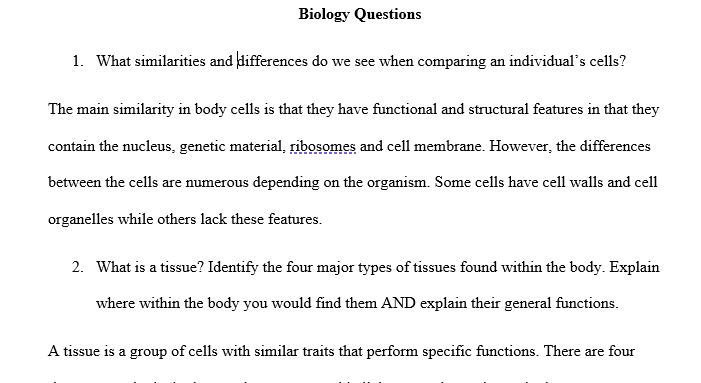What similarities and differences do we see when comparing an individual’s cells? What is a tissue? Identify the four major types of tissues
1.What similarities and differences do we see when comparing an individual’s cells?
2. What is a tissue? Identify the four major types of tissues found within the body. Explain where within the body you would find them AND explain their general functions.?
3. Identify the three major types of muscle tissue. Where do you find each of the types? Explain whether each of the three types is under voluntary or involuntary control. Which of the three
types are striated? Which are not?
4. What is an organ? Which five organs are considered vital for survival?
5. What is an organ system? Describe the general functions of each of the 11 organ systems of the body and know their basic components (organs).
6. Based on what you have read thus far this semester, put the following in order from least complex (or inclusive) to most complex (or inclusive): molecules, organs, organism, cells, organ systems, tissues, atoms. Which of these levels have the characteristics of life (and are, therefore, considered alive?)?
7. Anatomists standardize the way in which they view/describe body parts by relying upon a reference point called anatomical position. Describe anatomical position.
8. Practice using the following directional terms by explaining where body parts are relative to one another (while in anatomical position):
a. Superior/inferior (eg. The forehead is superior to the chin, while the chin is inferior to the
forehead)
b. Anterior/posterior
c. Medial/lateral
d. Proximal/distal
e. Superficial/deep
9. The human body is divided into body cavities, including the ventral cavity and the dorsal cavity.Describe the subdivisions (e.g. thoracic) of each of these cavities and the main organs found within them.
10. What is a serous membrane? Where, within the body, are they found and what function do they serve? Distinguish between the parietal and visceral serosa.
11. Where do we find mucous membranes and what function do they serve?
12. Which two body systems are most important for enabling communication between and coordination of the body systems?
13. What is homeostasis? Describe how homeostasis is maintained and explain its importance.
14. Distinguish between negative feedback and positive feedback. Provide an example of each.
15. Which of these is more important to maintaining your body temperature at a fairly constant
98.6°F?
Answer preview for What similarities and differences do we see when comparing an individual’s cells? What is a tissue? Identify the four major types of tissues

MLA
1110 Words